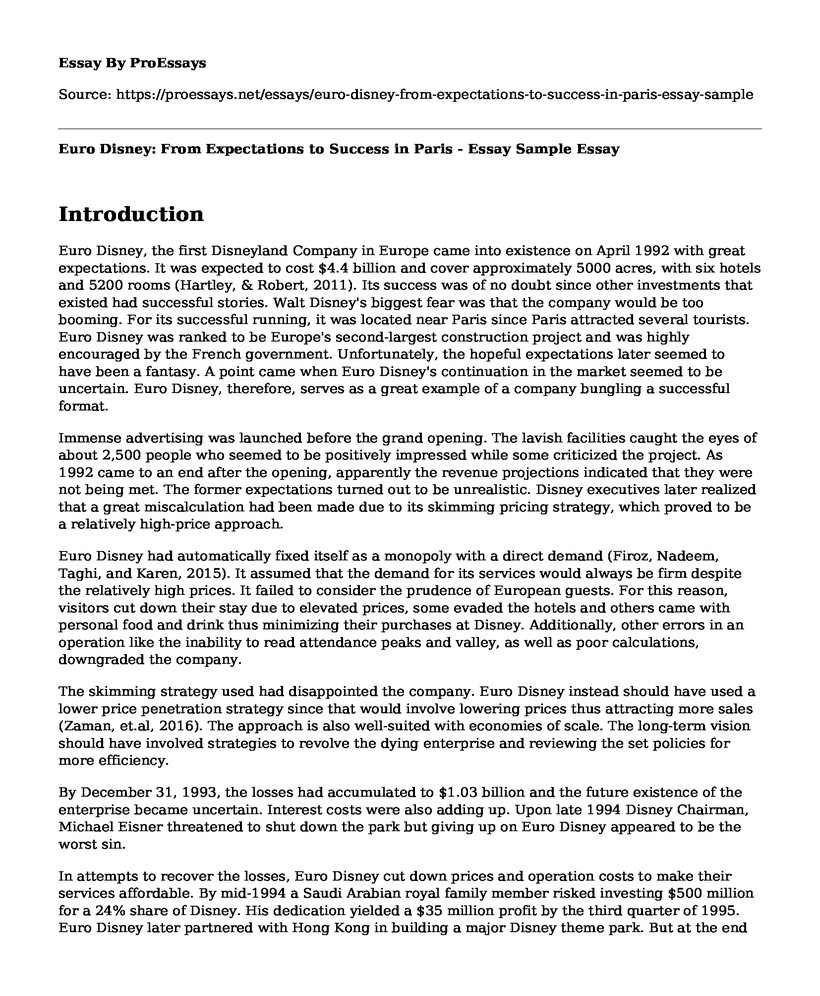Introduction
Euro Disney, the first Disneyland Company in Europe came into existence on April 1992 with great expectations. It was expected to cost $4.4 billion and cover approximately 5000 acres, with six hotels and 5200 rooms (Hartley, & Robert, 2011). Its success was of no doubt since other investments that existed had successful stories. Walt Disney's biggest fear was that the company would be too booming. For its successful running, it was located near Paris since Paris attracted several tourists. Euro Disney was ranked to be Europe's second-largest construction project and was highly encouraged by the French government. Unfortunately, the hopeful expectations later seemed to have been a fantasy. A point came when Euro Disney's continuation in the market seemed to be uncertain. Euro Disney, therefore, serves as a great example of a company bungling a successful format.
Immense advertising was launched before the grand opening. The lavish facilities caught the eyes of about 2,500 people who seemed to be positively impressed while some criticized the project. As 1992 came to an end after the opening, apparently the revenue projections indicated that they were not being met. The former expectations turned out to be unrealistic. Disney executives later realized that a great miscalculation had been made due to its skimming pricing strategy, which proved to be a relatively high-price approach.
Euro Disney had automatically fixed itself as a monopoly with a direct demand (Firoz, Nadeem, Taghi, and Karen, 2015). It assumed that the demand for its services would always be firm despite the relatively high prices. It failed to consider the prudence of European guests. For this reason, visitors cut down their stay due to elevated prices, some evaded the hotels and others came with personal food and drink thus minimizing their purchases at Disney. Additionally, other errors in an operation like the inability to read attendance peaks and valley, as well as poor calculations, downgraded the company.
The skimming strategy used had disappointed the company. Euro Disney instead should have used a lower price penetration strategy since that would involve lowering prices thus attracting more sales (Zaman, et.al, 2016). The approach is also well-suited with economies of scale. The long-term vision should have involved strategies to revolve the dying enterprise and reviewing the set policies for more efficiency.
By December 31, 1993, the losses had accumulated to $1.03 billion and the future existence of the enterprise became uncertain. Interest costs were also adding up. Upon late 1994 Disney Chairman, Michael Eisner threatened to shut down the park but giving up on Euro Disney appeared to be the worst sin.
In attempts to recover the losses, Euro Disney cut down prices and operation costs to make their services affordable. By mid-1994 a Saudi Arabian royal family member risked investing $500 million for a 24% share of Disney. His dedication yielded a $35 million profit by the third quarter of 1995. Euro Disney later partnered with Hong Kong in building a major Disney theme park. But at the end of 2004,
Disney was again making losses. In January 2005 the French government saw the need to revive the Euro Disney enterprise since it was the biggest employer in Paris by contributing $500 million from a state bank.
From the Disney journey, it is recommendable for investors to be cautious of a haughty mindset, especially in new ventures. They should understand that great success has no staying power and be careful with the skimming-price approach.
This case analysis proves to be a strong example of the outcome of bungling a successful format in any company. Poor marketing strategies bring great damage to a company like Euro Disney's worth. Euro Disney needed to review its policies and learn from the major mistakes they made (Yu, Irene HH, 2017). This applies to all investments in the market.
Work Cited
Hartley, Robert F. Management mistakes and successes. Hoboken, NJ: Wiley, 2011.
Firoz, Nadeem M., Taghi Ramin, and Karen Yau. "THE EURO: SUCCESS TO CRISIS." International Journal of Business & Economics Perspectives 10.1 (2015).
Zaman, Mustafeed, Laurent Botti, and Tan Vo Thanh. "WEIGHT OF HOTEL ATTRIBUTES: APPLICATION TO GUESTS OF DISNEYLAND PARIS HOTELS." 6th ADVANCES IN HOSPITALITY & TOURISM MARKETING & MANAGEMENT CONFERENCE. 2016.
Yu, Irene HH. "Investigating the poor financial performance of Disneyland Paris." (2017).
Grayson, Leslie E., et al. "Euro Disney or Euro Disaster?." Darden Business Publishing Cases (2017): 1-14.
Bruner, Robert F., John Langdon, and Anne Campbell. "Euro Disneyland SCA: Project Financing." Darden Business Publishing Cases (2017).
Cite this page
Euro Disney: From Expectations to Success in Paris - Essay Sample. (2023, Feb 27). Retrieved from https://proessays.net/essays/euro-disney-from-expectations-to-success-in-paris-essay-sample
If you are the original author of this essay and no longer wish to have it published on the ProEssays website, please click below to request its removal:
- Parents' Response to Child and Youth Gaming Essay
- Essay Sample on Loot Boxes: A Growing Challenge to Our Society
- Essay Sample on Growth of Microtransactions - A Response to the 21st Century Gaming Industry
- Pay-to-Win Video Games: Blessing or Curse? - Annotated Bibliography
- Essay Sample on Benefits of Hobbies: Stress Relief & More!
- Sony vs Microsoft: The Ultimate Gaming Console Showdown - Essay Sample
- Group Singing: Benefits to Mental & Physical Health - Essay Sample







